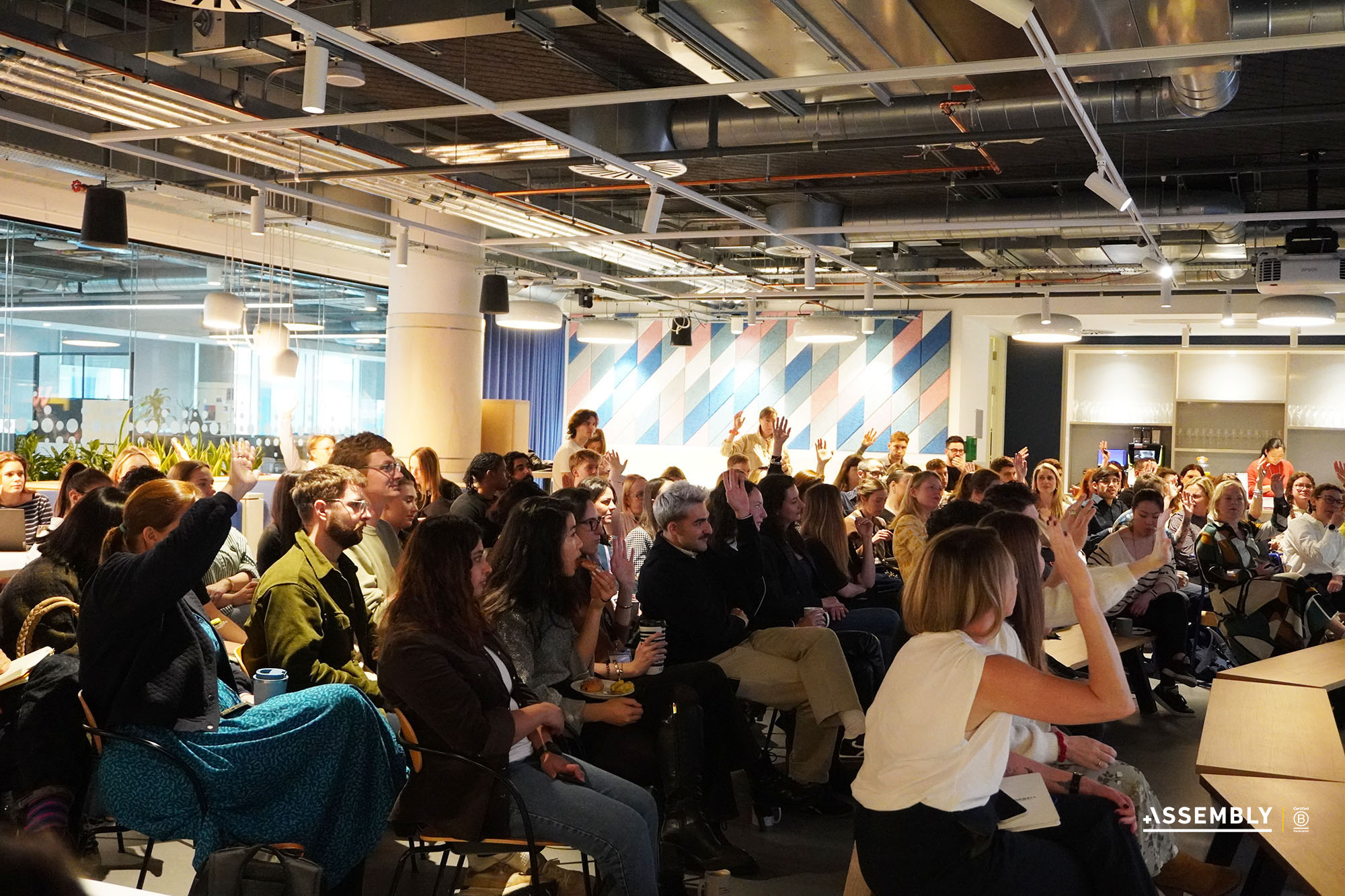
Navigating Sustainability in Advertising: Insights from the ‘Sunny Side Up’ Conference

Sustainability in advertising has evolved beyond a passing trend into a crucial business imperative. As brands face increasing pressure to adopt environmentally-conscious practices, they are tasked with the challenge of doing so authentically and effectively.
The ‘Sunny Side Up: A Brighter Future’ event took place on Wednesday at the Blue Fin Assembly’s Sustainability Conference, bringing together thought leaders from various industries to discuss how brands can navigate sustainability’s complexities in an ever-changing world.
From creative problem-solving to building trust with consumers, these panels emphasised the pivotal role that brands play in driving real, measurable change. With transparency and authenticity at the forefront, the advertising industry is learning to not only promote sustainability but also to live it across the business.

A Glimmer of Hope: How Optimism Drives Change
The morning began with a thought-provoking discussion in the ‘Reasons for Optimism’ panel, led by Gail Gallie, CEO and founder of Project Everyone. She explored how much brands should embrace sustainability in today’s increasingly-uncertain world, while reminding the audience of the power of optimism - hence the event name - and creativity in driving change, in her interview with Gaby Sethi, global head of impact at Assembly.
“There is no ‘normal’ anymore when it comes to sustainability efforts,” said Gaby, who pushed businesses to evolve and adapt now. Despite a volatile landscape, companies are committing to their sustainability targets: "Businesses are doubling down. They’ve set themselves targets, and they have shareholders and investors looking at the future and saying, 'If we don’t change, we’ll fail.' It's self-interest, but it’s also helpful from a sustainability perspective."
She continued, saying that businesses need to change how they communicate on the sustainability front, particularly if government pressures are trying to influence a reduction in sustainable investments and they’re tied into government contracts. She suggests that they can downplay efforts and using particular terms like "climate change" without needing to change their actions. Similarly, recognised the importance of creating more inclusivity in language used to describe sustainability efforts – as sometimes it can feel very unapproachable. “A lot of sustainability language has been preachy,” she says. “And this can alienate people who don’t understand it.”
Sustainability needs to be an integrated part of business, not just an afterthought or a marketing tactic. Looking at the rapid development of various Asian countries, like Singapore, where sustainability is embedded into their growth strategies is a good example of how this can be incorporated from the get-go.
Brands have a more significant role than ever in steering the conversation around sustainability. “They have enormous influence,” said Gaby. “And hopefully they’re made up of people like us making decisions” so there’s an opportunity for brands to lead by example.
It takes time for consumer behaviour to shift and inevitably people are unwilling to pay more for sustainable options and products. Companies therefore need to think more creatively to come up with solutions that factor this in and make choosing sustainably more of an accessible option. “We need systemic change,” said Gaby. “Brands need to make sustainable options the better options. Public transport so good that you don’t need a car. Businesses need to make the right choices for consumers.”
The Power of Media: Shaping Sustainability Narratives
The second panel, ‘Sustainability in Media’, explored the potential role that the media and government could play in inspiring sustainable change. Moderator Clare Chapman, CEO of Assembly Europe, talked about how governments and large corporations are rolling back on their sustainability commitments, despite an increase in extreme weather events around the world. But she took an optimistic spin, saying: “In the UK, emissions are at their lowest since 1872, mainly due to reduced coal dependency. That’s reason for hope.”
Director of sustainability at the Guardian, Julie Richards, echoed Clare’s concern but pointed to the growing demand for businesses to engage authentically. “People see the climate crisis unfolding – wildfires, extreme weather, rising sea levels,” she says. “They want to know what action leaders, whether politicians or businesses, are taking.” It’s an opportunity for brands to be more transparent and take real, meaningful action, as consumers expect more than polished marketing campaigns from brands and increasingly, want to see genuine efforts from companies.
The panel agreed that it’s up to brands and businesses to lead the charge. But Sophie Pemberton from Ad Net Zero, highlighted the gap between the industry’s progress and the Paris Agreement targets, noting, “We need at least a 3.6% reduction year-on-year to meet the Paris Agreement targets. Right now, we’re at just 1.7%.”
It’s a case of individuals and collectives educating themselves, reading quality journalism about the environment and actively shifting their mindsets to understanding the origins of products. Sophie Taylor, sustainability manager at Global media, called the industry to action: “Ask media owners for their lowest-carbon product. Just ask the question – it might lead to unexpected, headline-grabbing, even award-winning results. Have some nerve and don’t be afraid to push.”

Brands with Benefits: Trust, Transparency, and Real Impact
The final panel of the morning, 'Brands with Benefits', discussed how businesses can foster greater consumer trust by being more transparent and authentic, with moderator Olivia Hill, head of sustainability communications at Seismic, reminding the audience that sustainability is not just a trend but a business imperative. “76% of consumers want purpose-driven brands,” she said. “And 99% of investors consider ESG factors in their decision-making.”
“The power of business should be used for good, but it starts with the people,” said Charmain Love, chief international advocacy officer at Natura, which is a pioneer in the B Corp movement through its integration of sustainability into its business model. Charmain shared that Natura’s direct sales model empowers nearly four million beauty consultants, most of whom are women, to drive change in their communities. “What we do isn’t just about selling beauty products; it’s about empowering people to act and create systemic change.”
“Change happens at the speed of trust,” she added, addressing the need for companies to publicly report their positive and negative impacts. Natura’s integrated profit and loss tool, which tracks social, human, and natural capital, is an example of this commitment to openness. By being transparent about both their successes – and their challenges – companies can invite collaboration and innovation, creating a more authentic relationship with their audience.
“The onus is on brands, not consumers, to drive change,” said Lyall Millar, strategy partner at Assembly. He outlined three key ways brands can engage: through their operations and business models, by using their platforms to amplify sustainability messages, and by making conscious corporate spending choices.
But it can be difficult for brands to communicate their sustainability efforts. “We received two emails about plastic packaging over the last three years,” said Louisa Dodds, sustainability manager at Little Moons, illustrating that consumers don’t always demand sustainability from brands, but there is an expectation that businesses act responsibly nonetheless. “We don’t want to lecture people about climate change; instead, we use fun visuals and simple messaging.”
Brands need to remember that they can empower consumers to amplify their sense of personal agency. “Many young people feel a strong responsibility to act but doubt their ability to make a difference,” said Cleo Pascal, director at Humankind Research. Acting sustainably can feel overwhelming due to the scale of global issues, so it’s up to brands to present solutions in relatable and actionable ways.
“There’s no end point in sustainability; it’s always improving,” said Louisa. It’s a case of constantly reviewing and evolving sustainability strategies. For brands looking to stay relevant and responsible, the key takeaway is clear: sustainability is not just a business strategy; it is a tool for resonating with consumers and making a positive impact on the world.















